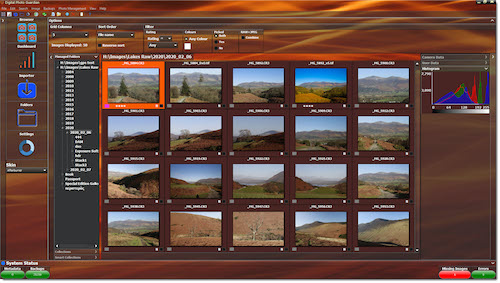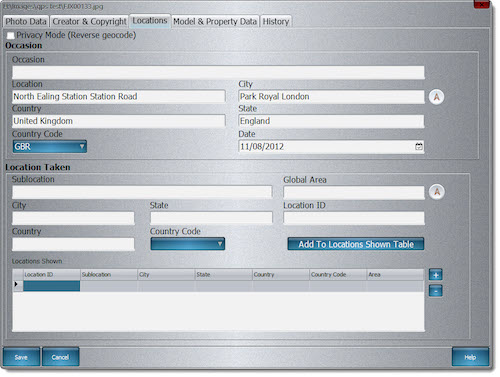Hi everyone,
today we continue our interview series with OpenCage customers looking at how they are using geocoding. In this post we chat with Andy Bell, founder of AB Photo Tools about their recently released Digital Photo Guardian, a desktop software for managing images.

1. Who are you and what do you do? What is AB Photo Tools?
I’m Andy Bell and I’ve been an IT Professional since the 1980s and a semi-professional photographer since 2015.
I first started programming on a Commodore 64, creating graphics, sounds and even business applications. In those days I wrote in assembly language - it was a great time to learn to program, everything was so new and innovative.
I then moved into the finance industry and wrote a suite of Mortgage Compliance applications for a local company. In 1995 I became a Software Consultant and designed and wrote applications for the medical, aviation, banking, insurance and manufacturing industries.
In 2002 I moved into the photographic industry and wrote a suite of applications for the digital photography world, including one of the first RAW converters to process images from multiple RAW formats.
Later on I returned to the finance industry and, with a global team, wrote enterprise applications to track and manage stock market portfolios.
I took a break from the software industry in 2015, spending my time working with a charity and selling my photographs internationally. In 2020 the Covid-19 pandemic affected my work greatly, leading me to return to the software industry and forming AB Photo Tools to market my software.
2. Image management is hardly a new field. What prompted you to build and launch Digital Photo Guardian now? What differentiates the software?
As part of my photography business, I maintain a blog at andybellphotography.com, where I review photographic equipment and software. As we approached the UK’s first lockdown in March 2020 I wrote a series of articles on Digital Asset Management for photographers. But when I examined the popular tools being used for this, I concluded that none of them were really management tools. They were image cataloging and organizing tools, but not true management tools.
For example, none of the tools I tested managed image backups, none warned in real time an image had been deleted or a backup was missing. Many just kept themselves up to date, often silently. Others didn’t even do that - they just ignored changes. Often, the first time you realize an image is missing is when you open the folder where it should be, only to find it gone or has an unhelpful exclamation mark beside it. For photographers with tens of thousands of images, it might take weeks or months before realizing that you had deleted a valuable image. By then, your backups, physical or cloud-based, may also have deleted the image.
The subject of metadata also interested me. The XMP specification is a wonderful thing, because it is extensible. But that creates a headache for Image Management tools. It is not possible to anticipate every extension that someone might add. But for a Digital Asset Management tool to have comprehensive search facilities, it must be able to support them.
Finally, image history was important to me. I’ve sometimes made the mistake of putting on the Internet a photo where I have completely renamed it, leaving no trace of the original filename. Finding the RAW file that is the source of that image is difficult, which is annoying when someone wants to buy a print!
So, in March 2020 I sat at home with my laptop and worked on a database that could meet all these challenges, and more. At first, it was a personal project. But, as I saw what I was achieving, I decided this was a commercial strength application. And in this way Digital Photo Guardian (DPG) was born, designed from the ground up to truly manage an image collection and be the hub that photography workflow revolves around.
DPG actively manages your images, warns of deletions and missing backups, can perform searches on any metadata item, produces reports and statistics, and maintains an inventory of your equipment.
DPG maintains an image’s history using an XMP extension, ensuring that edits do not orphan a JPEG from its parent RAW image.
If a photographer adds or deletes images from his photo collection when DPG is not running, DPG can run an integrity check and immediately warn of missing photos and backups.
3. How does AB Photo Tools make use of geocoding?

DPG uses the GPS information in the image metadata to display the image location on a map and to bring back the physical address of the GPS coordinates, using reverse geocoding. The professional version can perform batch reverse geocoding over multiple images.
4. How do you market the service? How do new customers become aware of your service?
The website, abphototools.co.uk has been online for a couple of months now, so some are aware of DPG and AB Photo Tools. I have mentioned it on my blog/YouTube channel a few times. Now that the program is ready for market, I’ll be creating more blog posts and videos, and posting regularly on social media. I’ll be informing other blogs, photographic communities and the press about the DPG. My aim is to grow it organically.
5. Any advice for anyone out there starting out and trying to build and sell their own software?
Don’t rush. Spend at least as much time designing and testing as you do coding. Use Agile development practices - software grows and evolves and it’s not possible to foresee everything in advance. DPG does things I never imagined when I started writing it, so it’s important to embrace change and code in a way that allows for it without compromising quality.
Be prepared for long days (and nights) and occasional frustration! When you can’t find a bug, stop. Take a break, go for a walk, or even have a day off. A fresh perspective is often all that you need to solve a problem.
Be aware that you can’t just publish a Windows application - you have to go through the process of getting a code signing certificate, which verifies that you are an authentic publisher. That takes time, as you have to provide proof of who you are and that you are genuine.
You also need to consider security carefully - having invested many, many months in your product, the last thing you want is to find a hacked/cracked version on the Internet.
6. What does the future hold for AB Photo Tools?
That’s a good question. I know well that this is a tough market to gain a foothold in and I’ll be carefully monitoring how DPG fares. I have a list of features that didn’t get into V1, and aim to do a series of incremental updates this year. Routines that actively assist with photographic workflow, sharing of images and more reports are all on the roadmap.
Thanks for the interview, Andy, and good luck with the new service. Great to see our geocoder in action. For a bit more technical background reader may enjoy our guide to geocoding images.
Happy geocoding,